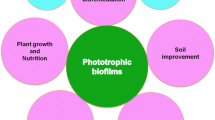Abstract
The ability of cyanobacteria to be useful as matrices for agriculturally important bacteria was evaluated. Biofilms were generated with the selected strain Anabaena torulosa after co-culturing with Azotobacter chroococcum, Pseudomonas striata, Serratia marcescens, and Mesorhizobium ciceri. The biochemical attributes were compared with individual bacterial and cyanobacterial cultures. The biofilms were characterized in terms of proteins, chlorophyll, IAA production, acetylene-reducing activity, phosphate solubilization, and antagonism towards selected phytopathogenic fungi. An enhancement in the population counts was recorded in A. torulosa–S. marcescens and A. torulosa–P. striata biofilms. The A. torulosa–A. chroococcum and A. torulosa–M. ciceri biofilms were also able to utilize new saccharides as compared to the individual cultures. Such novel biofilms with agriculturally useful traits can provide additional advantages including the broader spectrum of activity and the presence or formation of biologically active compounds; they also suggest the way to effective inoculants for sustainable and environment friendly agriculture.



Similar content being viewed by others
Abbreviations
- ARA:
-
Acetylene-reducing activity
- CD:
-
Critical difference
- CRYEMA:
-
Congo red yeast extract mannitol agar
- IAA:
-
3-Indole-acetic acid
- IARI:
-
Indian Agricultural Research Institute
- ITCC:
-
Indian Type Culture Collection
- NA:
-
Nutrient agar
- NB:
-
Nutrient broth
- ONPG:
-
4-Nitrophenyl beta-d-galactopyranoside
- PGPR:
-
Plant growth promoting rhizobacteria
- SEM:
-
Standard error of means
References
Arshad M Jr, Frankenberger WT (1998) Plant growth regulating substances in the rhizosphere: microbial production and function. Adv Agron 62:45–151
Fred EB, Baldwin IL, McCoy F (1932) Root nodule bacteria and leguminous plants. University of Wisconsin Press, Madison (Wisconsin)
Glick BR, Patten CL, Holguim G, Penrose DM (1999) Biochemical and Genetic Mechanisms Used by Plant Growth Promoting Bacteria. ICP, Covent Garden (London)
Gordon AS, Weber RP (1951) Colorimetric estimation of indole acetic acid. Plant Physiol 26:192–195
Gyaneshwar P, James EK, Mathan N, Reddy PM, Reinhold-Hurek B, Ladha JK (2001) Endophytic colonization of rice by a diazotrophic strain of Serratia marcescens. J Bacteriol 183:2634–2645
Hardy RWF, Burns RC, Holsten RD (1973) Application of the acetylene–ethylene assay for measurement of nitrogen fixation. Soil Biol Biochem 5:47–81
Herbert D, Phipps PJ, Strange RE (1971) Chemical analysis of microbial cells. In: Norris JR, Ribbons DW (eds) Methods in microbiology. New York, Academic Press, pp 209–344
Jensen HL (1954) The Azotobacteriaceae. Bacteriol Rev 18:195–214
Karthikeyan N, Prasanna R, Nain L, Kaushik BD (2007) Evaluating the potential of plant growth promoting cyanobacteria as inoculants for wheat. Eur J Soil Biol 43:23–30
Mandal BPL, Vlek G, Mandal LN (1999) Beneficial effect of blue green algae and Azolla excluding supplying nitrogen, on wetland rice fields: a review. Biol Fertil Soils 28:329–342
Manjunath M, Prasanna R, Lata N, Dureja P, Singh R, Kumar A, Jaggi S, Kaushik BD (2010) Biocontrol potential of cyanobacterial metabolites against damping-off disease caused by Pythium aphanidermatum in solanaceous vegetables. Arch Phytopathol Plant Protect 43:666–677
Moon SJ, Chen L, Moore RE, Patterson GML (1992) Calophycin, a fungicidal cyclic decapeptide form the terrestrial blue green algae Calothrix fusca. J Org Chem 57:1097–1103
Pikovskaya RE (1948) Mobilization of phosphorus in soil in connection with vital activity of some microbial species. Mikrobiologiya 17:362–370
Prasanna R, Nayak S (2007) Influence of diverse rice soil ecologies on cyanobacterial diversity and abundance. Wetlands Ecol Manag 15:127–134
Prasanna R (2008) Lata, Tripathi R.M., Gupta V., Middha S., Joshi M., Ancha R., Kaushik B.D.: Evaluation of fungicidal activity of extracellular filtrates of cyanobacteria – possible role of hydrolytic enzymes. J Basic Microbiol 48:186–194
Prasanna R, Jaiswal P, Nayak S, Sood A, Kaushik BD (2009a) Cyanobacterial diversity in the rhizosphere of rice and its ecological significance. Indian J Microbiol 49:89–97
Prasanna R, Nain L, Ancha R, Shrikrishna J, Joshi M, Kaushik BD (2009b) Rhizosphere dynamics of inoculated cyanobacteria and their growth-promoting role in rice crop. Egypt J Biol 11:26–36
Prasanna R, Joshi M, Rana A, Nain L (2010) Modulation of IAA production in cyanobacteria by tryptophan and light. Polish J Microbiol 59:99–105
Radhakrishnan B, Prasanna R, Jaiswal P, Nayak S, Dureja P (2009) Modulation of biocidal activity of Calothrix sp. and Anabaena sp. by environmental factors. Biologia 64:881–889
Rai AN, Bergman B (2002) Creation of new nitrogen-fixing cyanobacteria associations. (Special issue—biology and environment). Proc Roy Irish Acad 102B:65–68
Rasmussen U, Johansson C (2002) Diversity and specificity in cyanobacterial symbioses. (Special issue—biology and environment). Proc Roy Irish Acad 102B:53–56
Rosenberg M, Gutnik D, Rosenberg E (1980) Adherence of bacteria to hydrocarbons: a simple method for measuring cell surface hydrophobicity. FEMS Microbiol Lett 9:29–33
Sergeeva E, Liaimer A, Bergman B (2002) Evidence for production of the phytohormone indole-3-acetic acid by cyanobacteria. Planta 215:229–238
Spiro RA (1966) Analysis of sugars found in glycoproteins. In: Neufeld F, Ginsburg V (eds) Methods in Enzymology, vol 8. Academic Press, New York, pp 3–26
Stanier RY, Kunisawa R, Mandal M, Cohen-Bazire G (1971) Purification and properties of unicellular blue green algae (Order: Chroococcales). Bacteriol Rev 35:171–305
Svircev Z, Tamas I, Nenin P, Drobac A (1997) Co-cultivation of N2-fixing cyanobacteria and some agriculturally important plants in liquid and sand cultures. Appl Soil Ecol 6:301–308
Venkataraman GS (1981) Blue green algae for rice production. FAO Soils Bull. no.46
Whitton BA (2000) Soils and rice fields. In: Whitton BA, Potts M (eds) The Ecology of Cyanobacteria. Kluwer Academic Publishers, Dordrecht (The Netherlands), pp 233–255
Whitton BA, Aziz A, Kaweeka B, Rother A (1988) Ecology of deepwater rice-fields in Bangladesh. 3. Associated algae and macrophytes. Hydrobiologia 169:31–42
The authors are grateful to our Division and the Indian Council of Agricultural Research for providing the facility and financial support for our investigation, and to Dr. S. Chandrasekaran (Division of Genetics, IARI) for providing the microscopy and imaging facilities.
Author information
Authors and Affiliations
Corresponding author
Rights and permissions
About this article
Cite this article
Prasanna, R., Pattnaik, S., Sugitha, T.C.K. et al. Development of cyanobacterium-based biofilms and their in vitro evaluation for agriculturally useful traits. Folia Microbiol 56, 49–58 (2011). https://doi.org/10.1007/s12223-011-0013-5
Received:
Accepted:
Published:
Issue Date:
DOI: https://doi.org/10.1007/s12223-011-0013-5
Keywords
Profiles
- R. Prasanna View author profile



